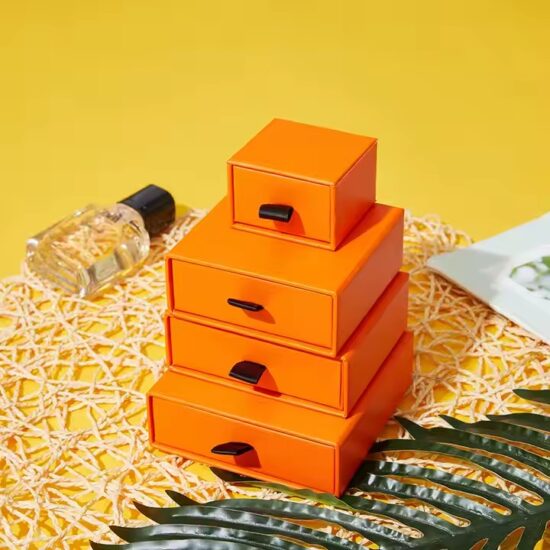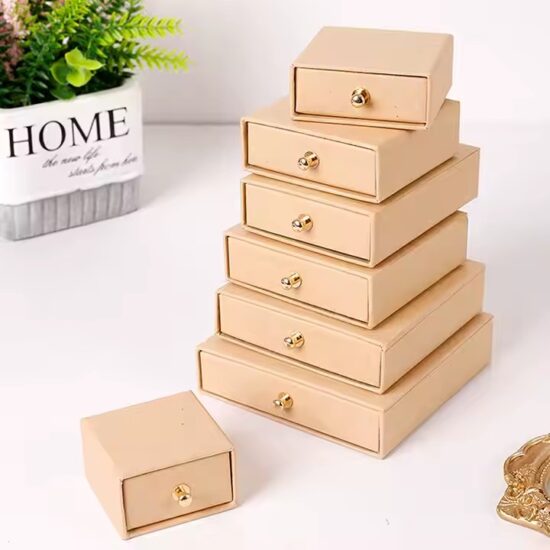jay@nbdho.com
Paper Jewelry Boxes vs. Other Materials: A Complete Comparison Guide
How Do Paper Jewelry Boxes Compare to Other Materials?
When choosing jewelry packaging, the material of the box plays a vital role in how your product is presented, protected, and perceived. Paper jewelry boxes have become increasingly popular, but how do they measure up to other traditional materials like plastic, wood, metal, and velvet?
Let’s explore a full comparison to help you decide the best packaging material for your jewelry business.
1. Paper Jewelry Boxes: Lightweight, Customizable, and Eco-Friendly
Pros:
-
Made from recyclable or biodegradable materials
-
Wide range of surface finishes (foil, embossing, printing)
-
Cost-effective for bulk orders
-
Lightweight for shipping
-
Suitable for modern, minimalistic, or eco-conscious brands
Cons:
-
Less durable than wood or metal
-
Not ideal for very heavy items
-
May be sensitive to moisture without lamination
Best for:
Gift jewelry, sustainable brands, promotions, and customizable packaging needs.
2. Plastic Jewelry Boxes: Affordable but Less Eco-Friendly
Pros:
-
Molded shapes offer high product protection
-
Waterproof and durable
-
Available in clear display styles (e.g. acrylic)
-
Good for mass-market, low-cost jewelry
Cons:
-
Non-biodegradable, difficult to recycle
-
Less premium in appearance
-
Increasingly avoided by eco-conscious buyers
Best for:
Low-cost accessories, kids’ jewelry, fast fashion packaging.
3. Wooden Jewelry Boxes: Luxurious and Long-Lasting
Pros:
-
High-end appearance and tactile quality
-
Durable and protective
-
Can be reused as keepsake boxes
-
Great for engraving or inlay work
Cons:
-
Expensive and heavy
-
Less versatile in design compared to paper
-
Not ideal for high-volume shipping
Best for:
Luxury jewelry lines, watches, heirloom pieces, and boutique gifting.
4. Metal Jewelry Boxes: Strong and Premium but Heavy
Pros:
-
Excellent protection
-
Distinctive, durable finish
-
Can be styled vintage, modern, or industrial
-
Often collectible
Cons:
-
High cost and weight
-
Can scratch easily without internal cushioning
-
Limited design flexibility
Best for:
Niche vintage brands, watch boxes, or statement packaging.
5. Velvet/Fabric-Covered Boxes: Elegant but Less Sustainable
Pros:
-
Soft, elegant texture
-
Often associated with wedding or luxury rings
-
Good perceived value
Cons:
-
Not eco-friendly
-
Easily stained or worn
-
Limited in branding options (hard to print or emboss)
Best for:
Engagement rings, fine jewelry, bridal collections.
📦 Side-by-Side Comparison Table
| Feature | Paper | Plastic | Wood | Metal | Velvet/Fabric |
|---|---|---|---|---|---|
| Eco-Friendly | ✅✅✅ | ❌ | ✅ (if FSC) | ❌ | ❌ |
| Cost | ✅✅✅ | ✅✅ | ❌❌ | ❌❌ | ✅✅ |
| Customization | ✅✅✅✅ | ✅✅ | ✅ | ✅ | ❌ |
| Appearance | ✅✅✅ | ✅ | ✅✅✅✅ | ✅✅✅ | ✅✅✅✅ |
| Durability | ✅✅ | ✅✅✅ | ✅✅✅✅ | ✅✅✅✅ | ✅✅ |
| Weight (Shipping) | ✅✅✅✅ | ✅✅✅ | ❌ | ❌ | ✅✅✅ |
🔍 Conclusion
Paper jewelry boxes are a versatile, affordable, and sustainable solution that continues to grow in popularity, especially among eco-conscious brands and gift-based retailers. While materials like wood and velvet offer timeless elegance, and plastic provides practicality, paper packaging offers the best combination of custom branding potential, design flexibility, and environmental friendliness.
Choosing the right material depends on your brand values, budget, and target audience—but for many, paper remains the most balanced and customizable choice.





